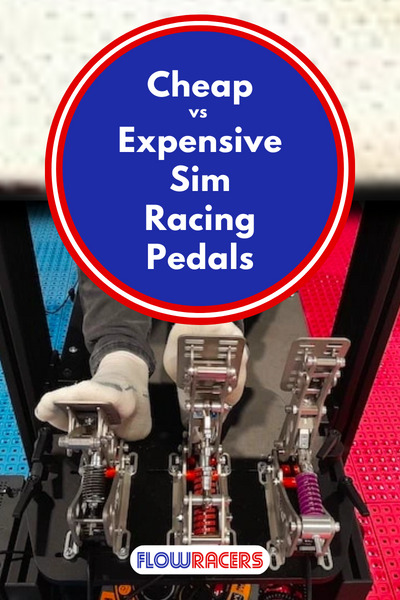It can be tough to make the choice between cheaper and more expensive sim racing pedals as a beginner. However, the decision becomes much easier to make when you understand the differences between cheap and expensive pedals.
Cheap sim racing pedals usually don’t offer as much immersion as higher-quality, more expensive sim racing pedals. They’re usually made with less durable materials, and they tend to use potentiometers for the brake pedal, rather than more realistic load cells or hydraulics.
Below, we go into more detail about the differences between cheap and expensive sim racing pedals so that you can make the right choice for your next set. We’ll then discuss a few of our favorite sim racing pedal manufacturers.

Why Are Sim Racing Pedals So Expensive?
Sim racing pedals are expensive because they are often made out of high-quality materials using complex manufacturing processes. They’re designed to replicate the feeling and behavior of pedals found in real race cars, and this comes at a high cost.
It goes without saying that all parts of your sim racing rig are pretty crucial, considering how everything works together to provide a realistic driving experience, but without the pedals you’ll really be missing a key part of that.
Improved Immersion
Having a set of pedals in general is a considerable improvement if you’ve simply been using a controller, even if they aren’t the best and all you’ve got is a 2-pedal set. A good sim racing pedal set does wonders for immersion and can even make you a more competitive driver.
High-Quality Materials
The more expensive pedals out there benefit from the perfect blends of lightweight metals and other durable materials to guarantee a longer product life without compromising on a competitive edge. These materials also make them look and feel more like the real thing.
The Features That Separate Cheap & Expensive Pedals
High-Grade Materials
More expensive pedals tend to be made of durable materials, rather than being primarily made of plastic. This doesn’t just make sure they last longer, but it also makes them sturdier, which is key when you consider the forces you’ll apply to your brake pedal in the corners.
More Immersion
This relates to not only the material matching the inside of a real race car’s cockpit (what car have you seen with plastic pedals?), but primarily to the varied ways in which resistance can be replicated using different systems.
Hydraulic brakes are a common feature in ultra-high-end pedal sets, but load cells are common too and immersive enough for most beginners and intermediate racers too. Some pedals also offer vibration to simulate ABS and traction control!
Reputable Brands
Well-known sim racing pedal brands usually offer long warranties on their expensive pedals for a reason, as they’re telling you that the product will be worth the price and last a long time. That’s why we recommend looking for pedals from well-respected brands (see the next section).
The Best Sim Racing Pedal Brands To Look Out For
The best sim racing pedal brands include:
- Heusinkveld (Sprint and Ultimate+ pedals)
- ProtoSimTech (PT2 pedals)
- HPP Simulation (HPP JBV hydraulic pedals)
- Simworx (Pro GT V3.1)
- Racewerk (S1 hydraulic pedals)
- Fanatec (CSL Elite V2s and ClubSport V3s)
- Thrustmaster (T-LCM pedals)
- Simtag (Simtag hydraulic pedals)
- MOZA (SR-P and CRP)
All of the above manufacturers are especially reputable and the favorites of sim racers the world over! They’re either specifically dedicated to the production of sim racing pedals, or generally produce high-end sim racing hardware for your whole rig.
Final Thoughts
More expensive sim racing pedals tend to be made of higher quality materials and offer more immersion. They also utilize more realistic mechanisms like load cells and hydraulics, while cheap pedals use potentiometers. It’s always best to opt for the best quality sim racing gear that you can afford.
I created and have been writing on this site since 2019, collaborating with drivers, coaches, engineers and manufacturers to provide you with the most reliable information about motorsport. I also make beautiful car posters and track posters.



